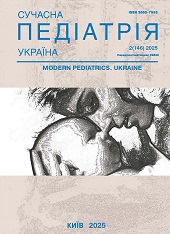Method of determining the amount of spine deformation in adolescent idiopathic scoliosis by angle measurement
DOI:
https://doi.org/10.15574/SP.2025.2(146).3945Keywords:
adolescent idiopathic scoliosis, Cobb's angle of deformation, spine, scoliometry, angometry, screening, diagnosis, X-ray examinationAbstract
In the structure of orthopedic pathology among children, the leading place is occupied by adolescent idiopathic scoliosis, the progressive nature of which leads to scoliotic disease and early disability. 80% of all types of scoliosis are idiopathic and 80% of them occur in adolescents, with the onset of pathology at the age of about 10 years.
Аim - determination of the main diagnostic approaches in identifying the features of clinical, functional and orthopedic manifestations of adolescent idiopathic scoliosis.
Materials and methods. The study included 30 patients (12 boys and 18 girls) aged 10 to 17 years with subjective clinical signs of adolescent idiopathic scoliosis of varying severity. The results of the examination of all patients were taken into account by us directly at the initial request for medical help, both subjective and objective methods.
Results. In order to minimize possible errors, we suggest determining the amount of deviation of the spine axis by measuring with a protractor the angle between the horizontal line that runs along the surface of the muscle shaft and goes to the spinous process of the vertebra and the line that runs perpendicular to the above-described line through the most outwardly protruding the point of the spinous process of the vertebra.
Conclusions. The proposed method makes it possible to monitor the development of the spine under the control of treatment results an unlimited number of times, allowing to determine the effectiveness of the chosen strategy of rehabilitation measures, to carry out an objective quantitative analysis of the expressiveness of the compensatory and restorative process with a certain prediction of possible results and consequences of the pathological process.
The research was carried out in accordance with the principles of the Declaration of Helsinki. Informed consent of the child's parents was obtained for the research.
The authors declare no conflict of interest.
References
Abul-Kasim K, Ohlin A. (2010). Curve length, curve form, and location of lower-end vertebra as a means of identifying the type of scoliosis. Journal of Orthopaedic Surgery. 18(1): 1-5. https://doi.org/10.1177/230949901001800101; PMid:20427824
Coelho DM, Bonagamba GH, Oliveira AS. (2013). Scoliometer measurements of patients with idiopathic scoliosis. Brazilian journal of physical therapy. 17(2): 179-184. https://doi.org/10.1590/S1413-35552012005000081; PMid:23778766
Delorme S, Labelle H, Aubin CÉ. (2002). The Crankshaft Phenomenon: Is Cobb Angle Progression a Good Indicator in Adolescent Idiopathic Scoliosis? Spine. 27(6): E145-E151. https://doi.org/10.1097/00007632-200203150-00009; PMid:11884919
Gardner A, Berryman F, Pynsent P. (2023). The relationship between minor coronal asymmetry of the spine and measures of spinal sagittal shape in adolescents without visible scoliosis. Scientific Reports. 13(1): 4294. https://doi.org/10.1038/s41598-023-31237-z; PMid:36922571 PMCid:PMC10017688
Goldyirev AYu, Ishal VA, Rozhdestvenskiy ME. (2000). Fiziologiya asimmetrii, frontalnyie narusheniya osanki, skolioz i skolioticheskaya bolezn. Vestnik novyih meditsinskih tehnologiy. 7(1): 88-90.
Kiel AW, Burwell RG, Moulton A, Purdue M, Webb JK, Wojcik AS. (1992). Segmental patterns of sagittal spinal curvatures in children screened for scoliosis: Kyphotic angulation at the thoracolumbar region and the mortice joint. Clinical Anatomy: The Official Journal of the American Association of Clinical Anatomists and the British Association of Clinical Anatomists. 5(5): 353-371. https://doi.org/10.1002/ca.980050503
Lotfi N, Chauhan GS, Gardner A, Berryman F, Pynsent P. (2020). The relationship between measures of spinal deformity and measures of thoracic trunk rotation. Journal of Spine Surgery. 6(3): 555. https://doi.org/10.21037/jss-20-562; PMid:33102892 PMCid:PMC7548823
Pesenti S, Prost S, Blondel B, Pomero V, Severyns M, Roscigni L et al. (2019). Correlations linking static quantitative gait analysis parameters to radiographic parameters in adolescent idiopathic scoliosis. Orthopaedics & Traumatology: Surgery & Research. 105(3): 541-545. https://doi.org/10.1016/j.otsr.2018.09.024; PMid:30930135
Rodrigues LMR, Ueno FH, Gotfryd AO, Mattar T, Fujiki EN, Milani C. (2014). Comparison between different radiographic methods for evaluating the flexibility of scoliosis curves. Acta ortopedica brasileira. 22(02): 78-81. https://doi.org/10.1590/1413-78522014220200844; PMid:24868184 PMCid:PMC4031250
Tiahur T. (2014). Suchasni metody diahnostyky skoliozu. Likuvalna fizychna kultura, sportyvna medytsyna y fizychna reabilitatsiia. 3(27): 98-104.
Wong LP, Cheung PW, Cheung JP. (2022). Curve type, flexibility, correction, and rotation are predictors of curve progression in patients with adolescent idiopathic scoliosis undergoing conservative treatment: a systematic review. The Bone & Joint Journal. 104(4): 424-432. https://doi.org/10.1302/0301-620X.104B4.BJJ-2021-1677.R1; PMid:35360948 PMCid:PMC9020521
Zheng R, Hill D, Hedden D, Mahood J, Moreau M et al. (2018). Factors influencing spinal curvature measurements on ultrasound images for children with adolescent idiopathic scoliosis (AIS). PLoS One. 13(6): e0198792. https://doi.org/10.1371/journal.pone.0198792; PMid:29912905 PMCid:PMC6005491
Downloads
Published
Issue
Section
License
Copyright (c) 2025 Modern pediatrics. Ukraine

This work is licensed under a Creative Commons Attribution-NonCommercial 4.0 International License.
The policy of the Journal “MODERN PEDIATRICS. UKRAINE” is compatible with the vast majority of funders' of open access and self-archiving policies. The journal provides immediate open access route being convinced that everyone – not only scientists - can benefit from research results, and publishes articles exclusively under open access distribution, with a Creative Commons Attribution-Noncommercial 4.0 international license (СС BY-NC).
Authors transfer the copyright to the Journal “MODERN PEDIATRICS. UKRAINE” when the manuscript is accepted for publication. Authors declare that this manuscript has not been published nor is under simultaneous consideration for publication elsewhere. After publication, the articles become freely available on-line to the public.
Readers have the right to use, distribute, and reproduce articles in any medium, provided the articles and the journal are properly cited.
The use of published materials for commercial purposes is strongly prohibited.

